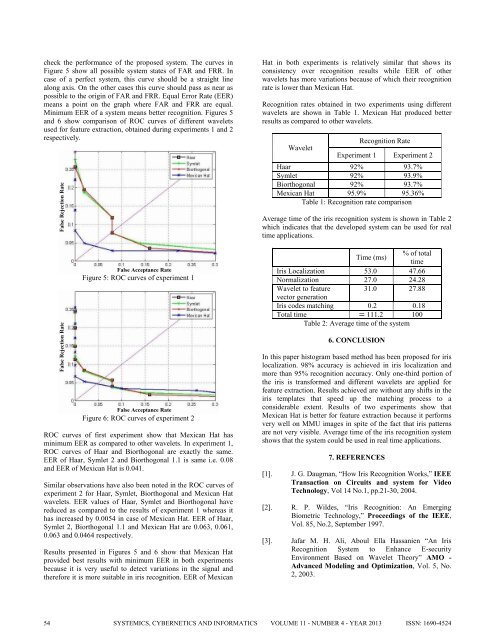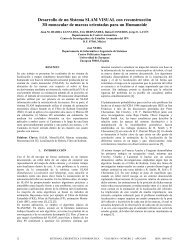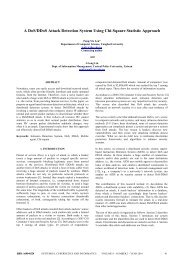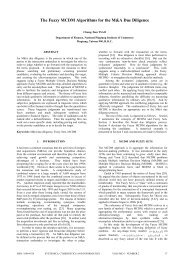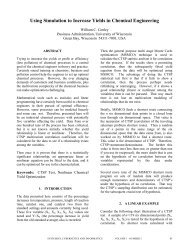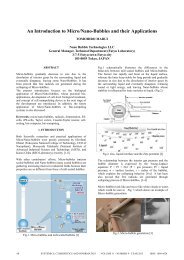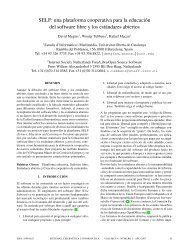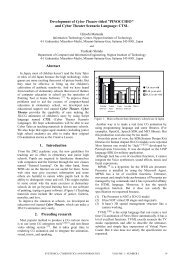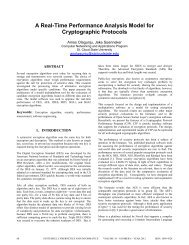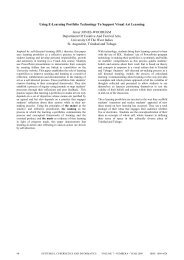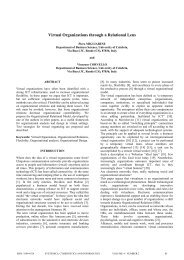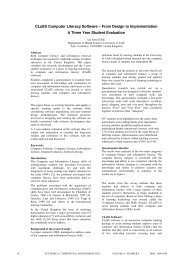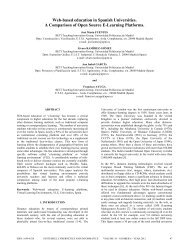IRIS RECOGNITION USING WAVELET
IRIS RECOGNITION USING WAVELET
IRIS RECOGNITION USING WAVELET
Create successful ePaper yourself
Turn your PDF publications into a flip-book with our unique Google optimized e-Paper software.
check the performance of the proposed system. The curves in<br />
Figure 5 show all possible system states of FAR and FRR. In<br />
case of a perfect system, this curve should be a straight line<br />
along axis. On the other cases this curve should pass as near as<br />
possible to the origin of FAR and FRR. Equal Error Rate (EER)<br />
means a point on the graph where FAR and FRR are equal.<br />
Minimum EER of a system means better recognition. Figures 5<br />
and 6 show comparison of ROC curves of different wavelets<br />
used for feature extraction, obtained during experiments 1 and 2<br />
respectively.<br />
False Rejection Rate<br />
False Rejection Rate<br />
False Acceptance Rate<br />
Figure 5: ROC curves of experiment 1<br />
False Acceptance Rate<br />
Figure 6: ROC curves of experiment 2<br />
ROC curves of first experiment show that Mexican Hat has<br />
minimum EER as compared to other wavelets. In experiment 1,<br />
ROC curves of Haar and Biorthogonal are exactly the same.<br />
EER of Haar, Symlet 2 and Biorthogonal 1.1 is same i.e. 0.08<br />
and EER of Mexican Hat is 0.041.<br />
Similar observations have also been noted in the ROC curves of<br />
experiment 2 for Haar, Symlet, Biorthogonal and Mexican Hat<br />
wavelets. EER values of Haar, Symlet and Biorthogonal have<br />
reduced as compared to the results of experiment 1 whereas it<br />
has increased by 0.0054 in case of Mexican Hat. EER of Haar,<br />
Symlet 2, Biorthogonal 1.1 and Mexican Hat are 0.063, 0.061,<br />
0.063 and 0.0464 respectively.<br />
Results presented in Figures 5 and 6 show that Mexican Hat<br />
provided best results with minimum EER in both experiments<br />
because it is very useful to detect variations in the signal and<br />
therefore it is more suitable in iris recognition. EER of Mexican<br />
Hat in both experiments is relatively similar that shows its<br />
consistency over recognition results while EER of other<br />
wavelets has more variations because of which their recognition<br />
rate is lower than Mexican Hat.<br />
Recognition rates obtained in two experiments using different<br />
wavelets are shown in Table 1. Mexican Hat produced better<br />
results as compared to other wavelets.<br />
Recognition Rate<br />
Wavelet<br />
Experiment 1 Experiment 2<br />
Haar 92% 93.7%<br />
Symlet 92% 93.9%<br />
Biorthogonal 92% 93.7%<br />
Mexican Hat 95.9% 95.36%<br />
Table 1: Recognition rate comparison<br />
Average time of the iris recognition system is shown in Table 2<br />
which indicates that the developed system can be used for real<br />
time applications.<br />
Time (ms)<br />
% of total<br />
time<br />
Iris Localization 53.0 47.66<br />
Normalization 27.0 24.28<br />
Wavelet to feature 31.0 27.88<br />
vector generation<br />
Iris codes matching 00.2 00.18<br />
Total time ≃ 111.2 100<br />
Table 2: Average time of the system<br />
6. CONCLUSION<br />
In this paper histogram based method has been proposed for iris<br />
localization. 98% accuracy is achieved in iris localization and<br />
more than 95% recognition accuracy. Only one-third portion of<br />
the iris is transformed and different wavelets are applied for<br />
feature extraction. Results achieved are without any shifts in the<br />
iris templates that speed up the matching process to a<br />
considerable extent. Results of two experiments show that<br />
Mexican Hat is better for feature extraction because it performs<br />
very well on MMU images in spite of the fact that iris patterns<br />
are not very visible. Average time of the iris recognition system<br />
shows that the system could be used in real time applications.<br />
7. REFERENCES<br />
[1]. J. G. Daugman, “How Iris Recognition Works,” IEEE<br />
Transaction on Circuits and system for Video<br />
Technology, Vol 14 No.1, pp.21-30, 2004.<br />
[2]. R. P. Wildes, “Iris Recognition: An Emerging<br />
Biometric Technology,” Proceedings of the IEEE,<br />
Vol. 85, No.2, September 1997.<br />
[3]. Jafar M. H. Ali, Aboul Ella Hassanien “An Iris<br />
Recognition System to Enhance E-security<br />
Environment Based on Wavelet Theory” AMO -<br />
Advanced Modeling and Optimization, Vol. 5, No.<br />
2, 2003.<br />
54 SYSTEMICS, CYBERNETICS AND INFORMATICS VOLUME 11 - NUMBER 4 - YEAR 2013 ISSN: 1690-4524


